Parasomnias are sleep-related disorders that cause unusual behaviors during sleep, like sleepwalking, night terrors, and REM behavior disorder. Sleepwalkers often move calmly during deep sleep without remembering episodes, while night terrors involve intense fear and frantic movements with little awareness. REM behavior disorder causes acting out vivid dreams due to muscle activity during REM sleep. Understanding these conditions helps you recognize their signs and explore effective ways to manage them, opening the door to more insights.
Key Takeaways
- Parasomnias are sleep disorders involving abnormal behaviors, movements, or perceptions during sleep, often linked to sleep cycle disruptions or emotional factors.
- Sleepwalking features calm, complex movements during deep sleep with little awareness, typically without memory of episodes.
- Night terrors cause intense fear and frantic movements during deep sleep, with minimal consciousness and usually no recall of episodes.
- REM Behavior Disorder involves acting out vivid dreams with physical movements during REM sleep due to loss of muscle paralysis.
- Diagnosis includes sleep diaries, polysomnography, and emerging AI tools, while management combines safety measures, behavioral therapy, and medication.
Understanding the Nature of Parasomnias
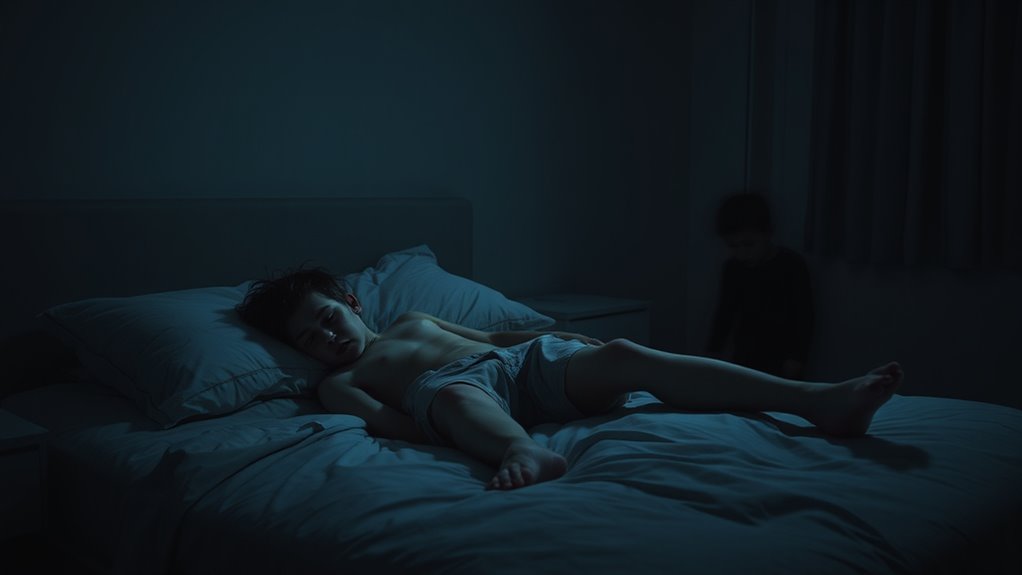
Parasomnias are a group of sleep disorders that involve abnormal behaviors, movements, emotions, perceptions, or dreams during sleep. To understand these disorders, you should explore dream analysis, which helps reveal underlying emotional or psychological triggers. Good sleep hygiene is essential, as it promotes a consistent sleep schedule, reduces stress, and creates a safe sleep environment, helping prevent or lessen parasomnias episodes. Recognizing the patterns and causes of these behaviors can empower you to take proactive steps toward managing them. While the exact mechanisms vary, many parasomnias are linked to disruptions in normal sleep cycles or heightened emotional states. By improving sleep hygiene and paying attention to your dreams, you can better understand and address the factors contributing to parasomnias. Additionally, understanding why we have dreams of falling can shed light on underlying anxieties that might influence parasomnias. Exploring sleep cycle disruptions can also provide insight into why these behaviors occur during specific sleep stages. Furthermore, some parasomnias are associated with underlying disorders in sleep regulation, highlighting the importance of comprehensive sleep assessments.
Differentiating Between Sleepwalking and Night Terrors

To tell sleepwalking apart from night terrors, consider the sleep state during each episode. Sleepwalkers often move calmly and have some awareness, while night terrors involve intense fear with little to no awareness. Pay attention to their behavior, movements, and memory of the event to distinguish between these common parasomnias. Additionally, understanding the inspirational quotes about fatherhood can help caregivers approach these episodes with patience and reassurance.
Sleep State During Episodes
Understanding the sleep state during episodes is key to differentiating between sleepwalking and night terrors. During sleepwalking, you usually occur in a slow-wave sleep stage, meaning you’re in a deep sleep with a low consciousness level. You’re not in a dream state, and your awareness of surroundings is minimal. In contrast, night terrors also happen during deep sleep, but your consciousness level remains very low, and you’re unlikely to remember the event. Unlike vivid dreams during REM sleep, these episodes involve intense fear without actual dreaming. Recognizing whether you’re in a true dream state or a non-dream deep sleep helps distinguish between the two parasomnias, guiding better understanding and management. Additionally, understanding the Honda Tuning modifications for vehicle performance can be metaphorically related to optimizing sleep quality by adjusting the “settings” of your sleep state for better health outcomes.
Furthermore, research in sleep studies indicates that the specific brain activity patterns during these episodes can provide insights into their underlying mechanisms, aiding in more targeted interventions and emphasizing the importance of precise brain activity analysis during sleep.
Behavior and Movement Patterns
Sleepwalking and night terrors often involve distinct movements and behaviors that help differentiate them. During sleepwalking, you may notice complex, coordinated movements like walking, opening doors, or even cooking. It’s a type of dream enactment, where your nocturnal movements mimic real actions. In contrast, night terrors usually involve sudden, frantic movements, such as thrashing or sitting upright, often accompanied by screams. You typically have little or no memory of the episode. Recognizing these behaviors can be crucial for understanding behavioral patterns during sleep.
Memory and Awareness Levels
Differentiating between sleepwalking and night terrors largely depends on how aware you are during the episodes. With sleepwalking, you often have little to no memory of what happened, making it feel like a blank slate. Night terrors, however, usually involve intense fear and vivid sleep hallucinations, yet you rarely remember them afterward. During sleepwalking, your awareness is minimal—you might act instinctively without realizing it. In contrast, night terrors can sometimes involve partial awareness, with episodes resembling lucid dreaming but accompanied by terror. To clarify:
- Sleepwalkers typically have no memory of their actions
- Night terrors can include vivid, frightening hallucinations
- Both may involve altered awareness, but to different degrees
- Sleep hallucinations and lucid dreaming experiences differ sharply in awareness levels
Understanding consciousness during these episodes can help distinguish between the two conditions. Additionally, these episodes are often linked to altered states of awareness, which are influenced by various sleep stages and individual factors. Recognizing the differences in awareness can aid in accurate diagnosis and management.
Characteristics of REM Behavior Disorder
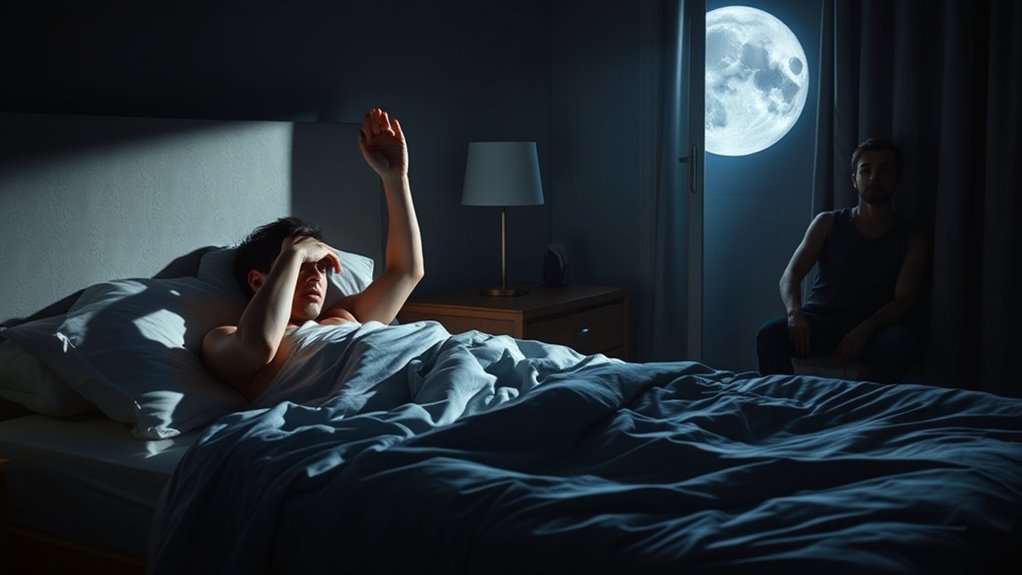
REM Behavior Disorder (RBD) is characterized by acting out vivid dreams during REM sleep, often resulting in physical movements or vocalizations. You might notice sudden, coordinated actions like talking, punching, or kicking while asleep. Unlike typical REM sleep, where muscles are usually paralyzed, RBD involves increased muscle activity, leading to dream enactment. This disorder can cause injuries to you or your bed partner. People with RBD often have complex behaviors that mirror their dreams, sometimes violent or energetic. Here’s a quick look at its characteristics:
| Characteristic | Description | Impact |
|---|---|---|
| Dream Enactment | Acting out vivid dreams | Can cause injury |
| Muscle Activity | Increased during REM sleep | Disrupted sleep cycle |
| Vocalizations | Talking or shouting in sleep | Disturbs sleep quality |
| Physical Movements | Kicking, punching, or jumping | Safety concerns |
Additionally, understanding the sleep cycle and its phases can help in recognizing how RBD deviates from normal sleep patterns. The neurodegenerative conditions associated with RBD may also contribute to its severity and prognosis. Recognizing sleep disruptions early can lead to better management and safety precautions.
Causes and Risk Factors of Sleep-Related Behaviors
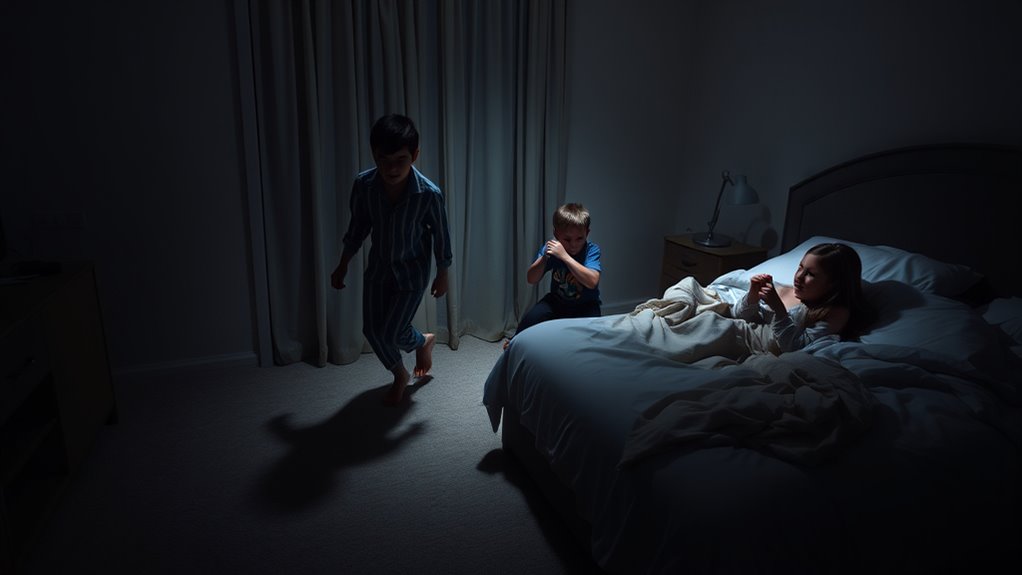
Your risk of sleep-related behaviors can increase due to genetic factors, so if family members have experienced similar issues, you might be more prone. Stress and anxiety also play a significant role, often disrupting your sleep patterns and triggering these behaviors. Additionally, sleep deprivation can heighten your chances of developing parasomnias, making restful sleep even more important.
Genetic Predispositions Increase Risk
Genetic factors play a significant role in increasing the likelihood of developing parasomnias. Your genetic influence can make you more susceptible if there’s a history of these behaviors in your family. Hereditary patterns suggest that sleep disorders like sleepwalking, night terrors, or REM behavior disorder often run in families. You’re more likely to experience these issues if close relatives have them. Understanding your genetic predispositions can help you identify risks early. Factors contributing to this increased risk include:
- Family history of parasomnias
- Specific gene mutations linked to sleep disorders
- Inherited sleep cycle irregularities
- Genetic links to neurological conditions
Knowing your genetic background empowers you to seek targeted interventions and better manage potential sleep issues.
Stress and Anxiety Factors
Stress and anxiety are common triggers that can markedly increase the likelihood of sleep-related behaviors like sleepwalking or night terrors. When you’re overwhelmed or anxious, your body releases stress hormones that disrupt your sleep cycle, making parasomnias more likely. Maintaining a calm sleep environment helps reduce these risks. You might find dream journaling helpful; recording your dreams and worries can identify stressors affecting your sleep. Creating a soothing sleep space—dim lighting, comfortable bedding, and minimal noise—supports relaxation. Managing daily stress through techniques like meditation or deep breathing can also lessen anxiety before bedtime. Incorporating sleep hygiene practices such as consistent sleep schedules and avoiding stimulants can further improve sleep quality. Ensuring your sleep environment is free from distractions and clutter can promote more restful sleep. Additionally, understanding the importance of parasomnia awareness can help you recognize early signs and seek appropriate treatment. By addressing stress and optimizing your sleep environment, you decrease the chances of experiencing sleep-related behaviors triggered by heightened anxiety.
Sleep Deprivation Effects
Sleep deprivation considerably increases the risk of sleep-related behaviors such as sleepwalking and night terrors. When you don’t get enough rest, your brain’s ability to regulate sleep cycles weakens, leading to disruptions that can trigger parasomnias. Poor sleep hygiene, like irregular schedules or excessive screen time before bed, worsens this effect. Lack of sleep also hampers dream analysis, making it harder to process emotions that may contribute to parasomnias. Additionally, sleep deprivation heightens stress levels, further destabilizing your sleep patterns. Being aware of these factors can help you better manage your sleep health and reduce risks. Prioritizing good sleep habits and understanding your sleep patterns are essential to prevent sleep-related behaviors from becoming a recurring problem.
Diagnosing Parasomnias: What to Expect
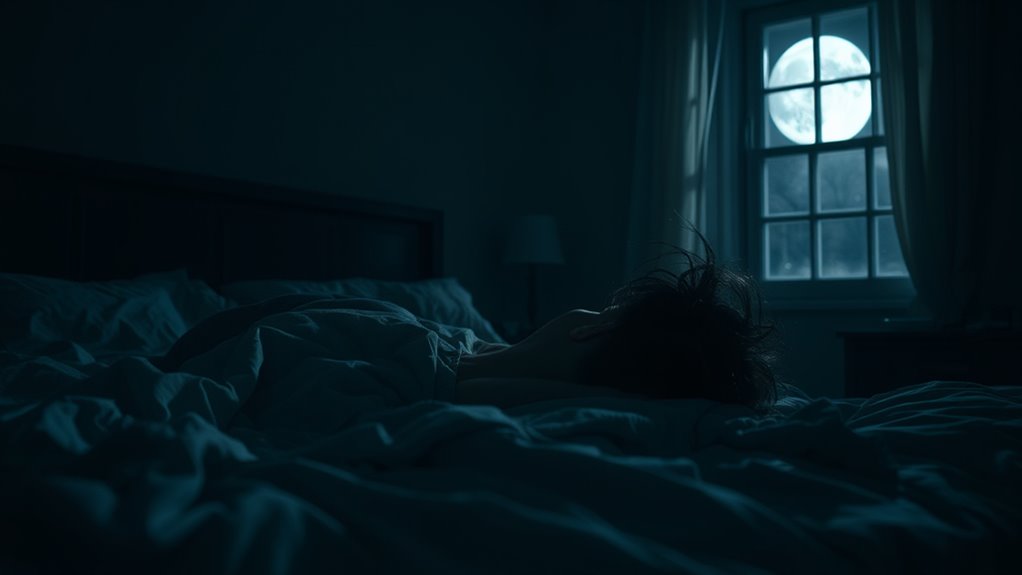
Diagnosing parasomnias involves a thorough evaluation of your sleep patterns and behaviors. Your doctor will likely ask you to keep a sleep diary, recording your sleep times, episodes, and any recall of unusual activities. They may also recommend neurological tests, such as EEGs, to rule out other conditions. During the assessment, a sleep study called polysomnography might be scheduled, where your brain waves, breathing, and movements are monitored overnight. This extensive approach helps pinpoint the specific parasomnia you’re experiencing. Understanding sleep disorders can also facilitate better diagnosis and management. Additionally, advancements in AI in education have led to developing tools that can assist in monitoring sleep patterns and behaviors, providing valuable data for diagnosis. Recognizing the importance of comprehensive assessment aligns with Louisiana Civil Code guidelines for accurate diagnosis and treatment planning.
Treatment Options and Management Strategies
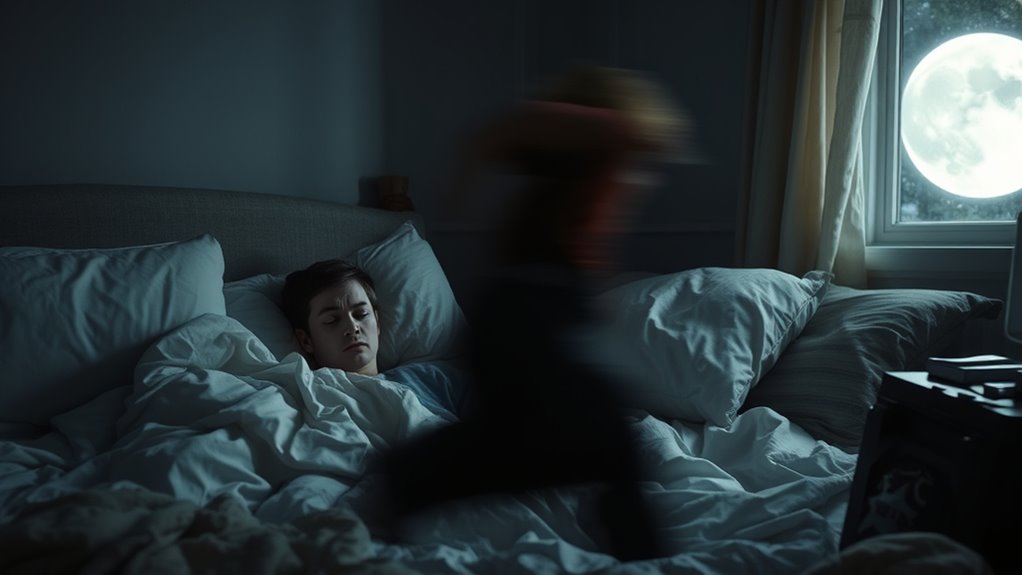
Once your healthcare provider has identified the specific parasomnia affecting you, they can recommend targeted treatment options and management strategies. These often include a combination of medication options and behavioral therapy to reduce episodes and improve sleep quality. Medication options might involve sedatives or antidepressants, depending on the parasomnia type. Behavioral therapy focuses on establishing a consistent sleep schedule, reducing stress, and creating a safe sleep environment. You may also learn relaxation techniques or cognitive-behavioral strategies to manage triggers. Here are some effective approaches:
Targeted treatments include medication, sleep routines, stress management, and creating a safe sleep space.
- Using medications as prescribed
- Implementing bedtime routines
- Managing stress through therapy
- Creating a safe sleep environment
In addition, understanding the boho lifestyle can encourage a holistic approach to sleep health by promoting a calming and harmonious environment. These strategies help control symptoms and promote restful, safe sleep.
Tips for Ensuring Safety During Sleep Episodes

Ensuring safety during sleep episodes is essential to prevent injuries and reduce risks associated with parasomnias. To improve night safety, start by removing sharp objects, securing windows, and installing safety gates if necessary. Consider using locks on doors and windows to prevent wandering, especially during sleepwalking episodes. Place alarms or motion sensors to alert you if someone gets up unexpectedly. Keep the sleep environment clutter-free, and avoid furniture that could cause falls. Use nightlights to reduce disorientation. Home precautions also include sleeping on the ground floor if possible and removing tripping hazards. Communicate with everyone in your household about your condition. These steps help create a safer sleep environment, minimizing injury risk and easing your mind during sleep episodes.
Frequently Asked Questions
Can Parasomnias Be Hereditary or Passed Down in Families?
You might wonder if parasomnias can run in your family. Research shows a genetic predisposition, meaning these sleep disorders can be passed down through family history. If relatives have experienced sleepwalking, night terrors, or REM behavior disorder, you’re more likely to develop them too. While genetics play a role, other factors like stress and sleep habits also contribute. Knowing your family history can help you recognize and manage these conditions early.
Are There Effective Natural or Alternative Therapies for Parasomnia Management?
Think of managing parasomnias like tuning an old instrument—you need gentle adjustments. You might try herbal remedies like valerian or chamomile to promote relaxation. Relaxation techniques such as deep breathing or meditation can help calm your mind before bed. While evidence varies, many find these natural methods effective in reducing symptoms. Always discuss with a healthcare professional to tailor a safe, holistic approach for your sleep health.
How Do Parasomnias Impact Long-Term Mental Health?
Parasomnias can profoundly impact your long-term mental health by increasing mental health risks like anxiety, depression, and emotional dysregulation. When you experience frequent disruptions or frightening episodes, it can strain your emotional regulation, leading to worse sleep quality and heightened stress. Over time, this cycle may worsen mental health issues, making it crucial to address parasomnias early to protect your emotional well-being and maintain overall mental stability.
Can Lifestyle Changes Reduce the Frequency of Parasomnia Episodes?
Ever wonder if lifestyle changes can lessen parasomnia episodes? You can definitely reduce their frequency by improving your sleep hygiene—like sticking to a consistent sleep schedule and creating a calming bedtime routine. Stress reduction techniques, such as meditation or deep breathing, also help calm your mind before bed. These adjustments create a safer, more restful environment, helping you experience fewer episodes and better overall sleep quality.
Are Children More Prone to Specific Types of Parasomnias?
You might notice that children are more prone to certain parasomnias because of their developing pediatric sleep patterns and ongoing childhood neurological development. During this stage, their brains are still maturing, making them more susceptible to sleep disruptions like sleepwalking or night terrors. These episodes often decrease as their neurological systems stabilize with age. Understanding this connection helps you support healthier sleep habits during their vital growth years.
Conclusion
Just as the night holds secrets like the moon’s hidden face, parasomnias can surprise you. By understanding these sleep behaviors, you’re better equipped to navigate their mysteries. With proper diagnosis, treatment, and safety tips, you can turn restless nights into peaceful dreams. Remember, knowledge is your guiding star—helping you find calm in the darkness and wake up ready to face each new day with confidence. Sleep well, and let tranquility be your guiding light.









